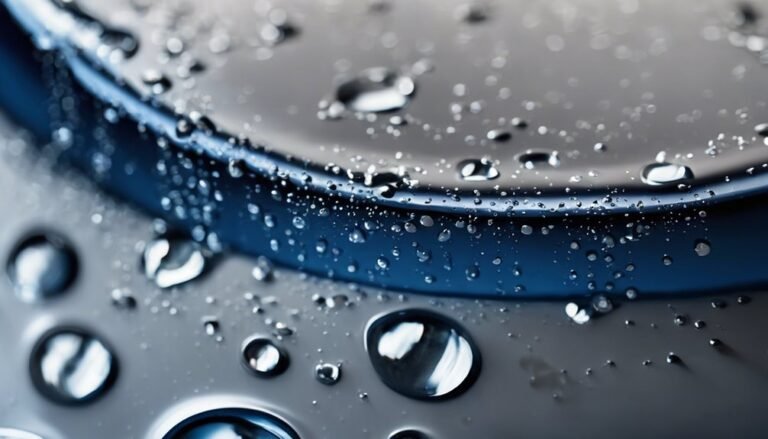Will Sludge in Water Softner Tank Get Into Water System?
Imagine a household where the water suddenly turns murky and smells foul, prompting concern about the water's quality. You might wonder, could sludge in the water softener tank be the culprit? If not regularly monitored, this buildup can indeed find its way into your home's water supply, leading to potential health risks and costly repairs. Understanding the factors that contribute to sludge formation and its implications on water quality is vital. So, what steps can you take to guarantee your water remains clean and safe?
Key Takeaways
- Sludge in the water softener tank can enter the water system if not properly maintained or cleaned regularly.
- Contaminated sludge may contain harmful bacteria and toxins that pose health risks when ingested.
- Signs of sludge accumulation, like discolored or foul-smelling water, indicate potential contamination of the water supply.
- Regular maintenance and cleaning of the brine tank help prevent sludge from affecting the water system.
- Professional evaluation is recommended if sludge buildup is suspected to ensure water safety and system efficiency.
What Is Sludge in Water Softeners?
Sludge in water softeners refers to the buildup of debris, minerals, and organic materials that accumulate at the bottom of the tank over time. This sludge composition typically includes calcium, magnesium, iron, and small particles from the water supply or the softening process itself.
As you use your water softener, these materials settle and create a layer of sludge that can affect the efficiency of your system. Understanding the sludge composition is essential for effective water treatment in your home.
If you ignore this buildup, it can lead to blockages, reduced water flow, and even damage to your softener. The sludge can also harbor bacteria, which may pose a risk to your water quality. Regular maintenance and monitoring are necessary to prevent these issues.
By keeping an eye on the tank, you can make certain that the sludge doesn't interfere with the system's performance. In short, sludge in your water softener isn't just an annoyance; it can disrupt the entire water treatment process.
Addressing it promptly will help maintain the efficiency and longevity of your water softener, guaranteeing you get the soft water you need.
Causes of Sludge Formation
Sludge in your water softener tank often forms due to hard water minerals accumulating over time.
You might also notice that bacterial growth can contribute to this issue, especially if the system's maintenance isn't taken seriously.
Understanding these causes will help you keep your water softener running efficiently.
Hard Water Minerals
Hard water minerals, particularly calcium and magnesium, are the primary culprits behind sludge formation in water softener tanks. When you have hard water, these minerals accumulate over time, leading to mineral buildup that can clog your system.
As your water softener works to remove these minerals, it sometimes can't keep up with the sheer volume, creating a sludge that settles at the bottom of the tank. This sludge is a combination of the minerals that have been removed from the water and those that haven't, resulting in a sludge layer that can interfere with the softening process.
If you don't regularly maintain your water softener, this buildup can become significant, causing the unit to work less effectively and potentially damaging it.
To prevent sludge formation, consider testing your water regularly and maintaining your water softener according to the manufacturer's guidelines. You might also explore using a pre-filter to reduce the amount of hard water entering your system.
Bacterial Growth Issues
Bacterial growth can greatly contribute to sludge formation in your water softener tank, often exacerbating the problems caused by hard water minerals. When bacteria thrive, they can lead to bacterial contamination, which not only creates sludge but may also affect the efficiency of your water treatment system. It's vital to recognize the conditions that promote this undesirable growth.
Here's a quick summary of factors that can lead to bacterial growth:
| Factor | Impact on Sludge Formation |
|---|---|
| Excessive moisture | Encourages bacterial reproduction |
| Poorly maintained systems | Increases nutrient availability for bacteria |
| Organic matter presence | Provides food sources for bacterial growth |
| Low water flow rates | Creates stagnant conditions ideal for bacteria |
| High temperatures | Accelerates bacterial activity |
To prevent these issues, it's important to regularly maintain your water softener and guarantee a proper water treatment regimen. By doing so, you can minimize bacterial growth and its contribution to sludge, keeping your system running efficiently.
Risks of Sludge Contamination
Contaminated water from a softener tank can pose serious health risks to you and your family. When sludge builds up, it can harbor harmful bacteria and toxins that may end up in your water supply. If you don't address sludge removal promptly, you're increasing the likelihood of contamination, which could lead to gastrointestinal issues, skin irritations, or other health problems.
You mightn't realize how often you use water from your softener—cooking, drinking, and bathing all rely on it. Contamination prevention is vital to guarantee your family's safety.
Regular maintenance of your water softener is essential; if you let sludge accumulate, it can be challenging to remove and may require professional help.
Additionally, if the sludge contains harmful substances, it can compromise the effectiveness of your softener, making it harder to achieve soft water.
How Sludge Affects Water Quality
Sludge accumulation in your water softener tank can greatly degrade water quality. When this sludge builds up, it can introduce contaminants into your water supply, impacting both taste and safety. You might notice a cloudy appearance or unpleasant odors, which are clear signs that your water isn't as clean as it should be.
Additionally, the presence of sludge can lead to the growth of harmful bacteria, further compromising your water quality. If left unaddressed, this sludge can clog the system, making your water softener less effective. You may find that your water feels harder, resulting in soap scum buildup on dishes and fixtures.
Ultimately, poor water quality can affect not just your household, but also your appliances, leading to costly repairs and replacements. Regular sludge removal is essential to maintaining peak water quality. By keeping your water softener tank clean, you guarantee that the system functions efficiently and delivers the clean, soft water you expect.
Don't underestimate the importance of routine maintenance; it's a key step in safeguarding your water quality for the health and comfort of your home.
Maintenance Tips for Water Softeners
To guarantee your water softener continues to function at its best and delivers high-quality water, regular maintenance is key.
Start by performing regular inspections of your unit. Check the salt levels in the brine tank monthly, and refill with high-quality salt as needed. If you notice a significant drop in salt levels, it might indicate a problem that requires attention.
Next, clean the brine tank every six months to remove any sludge or sediment that may have accumulated. This helps maintain efficiency and prevents issues down the line.
Also, examine the resin beads in the tank; if they appear discolored or worn out, consider replacing them.
You should also keep an eye on the water softener's settings. Verify that the regeneration cycle is set correctly for your water usage and hardness levels. It's beneficial to test your water periodically to verify your softener is effectively removing minerals.
Lastly, schedule professional maintenance annually. A technician can perform a thorough inspection and address any significant issues before they escalate.
Signs of Sludge Buildup
Noticing a decrease in your water softener's efficiency? You might be dealing with sludge buildup in the tank. Ignoring this issue can lead to poor water filtration and costly repairs.
Here are some signs that sludge is becoming a problem:
- Cloudy or Discolored Water: If your water looks murky or has a strange color, that's a red flag.
- Unpleasant Odors: A foul smell coming from your tap water might indicate that sludge is lurking in your system.
- Increased Soap Use: If you find yourself using more soap than usual for washing dishes or laundry, your softener mightn't be working effectively due to sludge.
- Frequent Regeneration Cycles: If your water softener seems to regenerate more often without any changes in your water usage, sludge may be accumulating.
If you notice any of these signs, it's time to evaluate sludge removal.
Addressing sludge buildup not only improves your water quality but also enhances the overall efficiency of your water softener.
Don't let sludge compromise your home's water filtration system!
Preventing Sludge Accumulation
Addressing the signs of sludge buildup is just the first step; preventing it from happening in the first place can save you time and money down the line. Implementing effective sludge prevention techniques is essential for maintaining your water treatment system. Here are some key strategies to evaluate:
| Action | Description |
|---|---|
| Regular Maintenance | Schedule routine checks and cleanings. |
| Quality Salt | Use high-purity salt to reduce impurities. |
| Water Softener Settings | Adjust settings based on your water hardness. |
| Monitor Water Quality | Test water regularly to catch issues early. |
When to Call a Professional
If you notice signs of sludge accumulation in your water softener, it's time to take action.
Ignoring the issue can lead to health risks and potentially costly repairs down the line.
Knowing when to call a professional can save you time and guarantee your system runs smoothly.
Signs of Sludge Accumulation
Sludge accumulation in your water softener tank can lead to a host of problems, making it essential to recognize the signs early.
If you notice any of the following indicators, it's time to evaluate sludge removal and possibly call a professional for help.
- Unpleasant Odors: A foul smell coming from your water or softener tank may indicate sludge buildup.
- Discolored Water: If you start seeing brown or cloudy water, it could be a sign that sludge is infiltrating your water filtration system.
- Reduced Water Pressure: Sludge can restrict flow, resulting in lower water pressure throughout your home.
- Frequent System Regeneration: If your water softener is regenerating more often than usual, it might be struggling to process due to sludge.
Ignoring these signs can lead to more severe issues, including damage to your water softener and compromised water quality.
Don't wait until the problem worsens; being proactive about sludge removal can save you time and money in the long run.
If you notice any of these signs, it's best to consult a professional for an assessment and appropriate solutions.
Health Risks Involved
Ignoring the signs of sludge accumulation can pose significant health risks. If you notice sludge building up in your water softener tank, it's essential to address it promptly. Sludge can harbor harmful bacteria and contaminants that may compromise your water safety.
Over time, these impurities can leach into your home's water supply, leading to potential health implications for you and your family. You might experience gastrointestinal issues, skin irritations, or other ailments linked to contaminated water.
Even if your water appears clear, invisible pathogens can still be present, putting your health at risk. If you suspect that sludge is affecting your system, don't hesitate to call a professional. They can assess the situation and guarantee your water is safe for consumption.
Regular maintenance is critical, but knowing when to seek expert help is equally important. If you're unsure or if the sludge appears extensive, reach out to a qualified technician.
Prioritizing water safety not only protects your health but also helps maintain the integrity of your plumbing system. Remember, staying proactive can prevent serious health issues down the line.
Maintenance and Repair Services
Regular upkeep of your water softener is essential for its performance and your family's health.
While you can handle some basic maintenance, there are times when it's best to call in a professional.
Here are some signs that indicate it's time to seek expert help:
- Frequent Salt Bridge Formation: If you notice salt bridges forming often, it could indicate a deeper issue that requires a professional's insight.
- Ineffective Softening: If your water still feels hard despite recent regeneration cycles, it's time to consult an expert.
- Unpleasant Odors: Strange smells from your water softener might point to sludge buildup or other problems that need immediate attention.
- System Upgrades Needed: If you're considering preventive measures or system upgrades to enhance performance, a professional can guide you through the best options.
Frequently Asked Questions
Can Sludge Affect the Lifespan of My Water Softener?
Sludge can definitely shorten your water softener's lifespan. By prioritizing water softener maintenance and implementing sludge prevention measures, you'll guarantee efficient operation and prolong its durability, saving you money and hassle in the long run.
How Often Should I Check for Sludge Buildup?
Think of your water softener like a car; regular check-ups keep it running smoothly. You should inspect for sludge buildup every three months as part of your routine maintenance and follow those sludge prevention tips for peak performance.
What Are the Symptoms of Sludge Affecting My Water Supply?
If you're noticing discolored water, a strange taste, or reduced water pressure, sludge causes might be at play. Regular maintenance and sludge prevention techniques can help you avoid these issues and keep your water supply clean.
Is Sludge Harmful to Pets and Plants?
Sludge can pose risks to pets and plants due to its potential toxicity. You should guarantee pet safety by preventing access to contaminated water and regularly monitoring your plants for any adverse effects from sludge exposure.
Can I Remove Sludge Myself or Need a Professional?
You can tackle sludge removal yourself with proper techniques and DIY maintenance. However, if you're unsure or the sludge is significant, it's wise to consult a professional for effective and safe removal.
Conclusion
In summary, keeping an eye on sludge in your water softener tank is essential for your health and home. After all, would you want murky water flowing through your taps? Regular maintenance and awareness of signs can save you from unpleasant surprises. By taking proactive steps, you guarantee clean, safe water for you and your family. Don't let sludge sneak into your system—stay vigilant and enjoy the peace of mind that comes with pure water!







